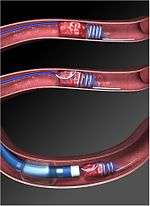MERCI Retriever

The MERCI Retriever is a medical device designed to treat Ischemic Strokes. The name is an acronym for Mechanical Embolus Removal in Cerebral Ischemia. Designed by University of California, Los Angeles in 2001, MERCI was the first device approved in the U.S. to remove blood clots in patients suffering from acute brain ischemia.[1]
History
The MERCI Retriever obtained U.S. FDA clearance in August 2004 for re-canalization of cerebral arteries in acute stroke.[2]
Previously, the only available treatment to acute brain strokes was through the use of a protein that breaks down blood clots called tPA. The treatment process itself is termed the r-tPA method (Recombinant Tissue Plasminogen Activator). The success of the r-tPA is strongly dependent on short onset of stroke symptoms, which had to be less than 3 hours. Hemorrhagic complications were also highly likely to occur using the r-tPA method, especially in older brain-stroke patients, which in turn resulted in high mortality rates after the treatment.
According to Dr. Y. Pierre Gobin, one of the inventors of the MERCI device at UCLA, the idea of the MERCI device arose in 1995 during the treatment of a particularly difficult stroke incident. Failing to treat the blockage chemically, Gobin and his Fellow, Dr. J.P. Wensel, concluded that a mechanical device was needed to remove blood clots faster, and with less risk of hemorrhage.
Gobin and Wensel designed several different shapes, and finally settled on a helical configuration. They began animal studies with the device at UCLA in 1996.
The project was successful in the animal studies, and eventually found sufficient investors to form the company Concentric Medical to develop the device for human use. After two years, in 2001, clinical lab safety studies began, leading to success. The first two patients treated at UCLA with the MERCI retriever (called the Concentric Retriever at the time) showed normal blood flow as a result of the successful procedure.
Mechanism
In an ischemic stroke, there is an obstruction within blood vessels that supply blood to the brain. The goal in treatment of such a stroke is to restore blood flow through these blood vessels. The MERCI retriever does so by allowing the removal of the blood clots causing the obstruction.
The retriever consists of a long thin wire with a helical coil formed at the distal end. A balloon catheter is snaked into the affected vessel from the femoral artery, and the balloon is inflated to prevent blood flow that could hinder the retrieval process. The retriever is then fed through the catheter, during which the distal coil is straightened to fit through the catheter tube. When the retriever emerges at the clot site, the coil reforms, wrapping around the clot and allowing the clot to be removed with the catheter.[3]
FDA Process
Concentric Medical undertook a preliminary study of the MERCI retriever to assess its effectiveness.[4] The manufacturers of the MERCI device filed a 510(k) premarket notification, and received an FDA premarket approval in 2004.
Outcomes
The MERCI Retriever was highlighted in 2008 on the CBS TV show The Doctors. Dr. Reza Jahan, a neuro-interventionist at UCLA, explained the device and its operation.[5] As of 2012, 10,000 patients have been treated with the MERCI Retriever. Its primary advantage over prior treatment methods is its ability to clear clots as long as 8 hours after the ischemic event.[2] In addition, the Merci Retriever, achieved 48% vessel re-canalization[2] and lower mortality rates than the use of r-tPA in revascularized patients.[2]
References
- ↑ "The MERCI retriever story". Retrieved 17 September 2012.
- 1 2 3 4 Katz, JM; Gobin, YP (May 2006). "Merci Retriever in acute stroke treatment.". Expert Review of Medical Devices. 3 (3, number 3): 273–280. doi:10.1586/17434440.3.3.273. PMID 16681448.
- ↑ Medical Surgical Nursing: Assessment and Management of Clinical Problems. Wiley-Blackwell. 2009–2011. pp. 1469–1470. ISBN 9780323036887.
- ↑ "Multi MERCI". ClinicalTrials.gov. U.S. National Institute of Health. Retrieved 2012-09-13.
- ↑ "The Doctors, episode: Strokes". 2008.